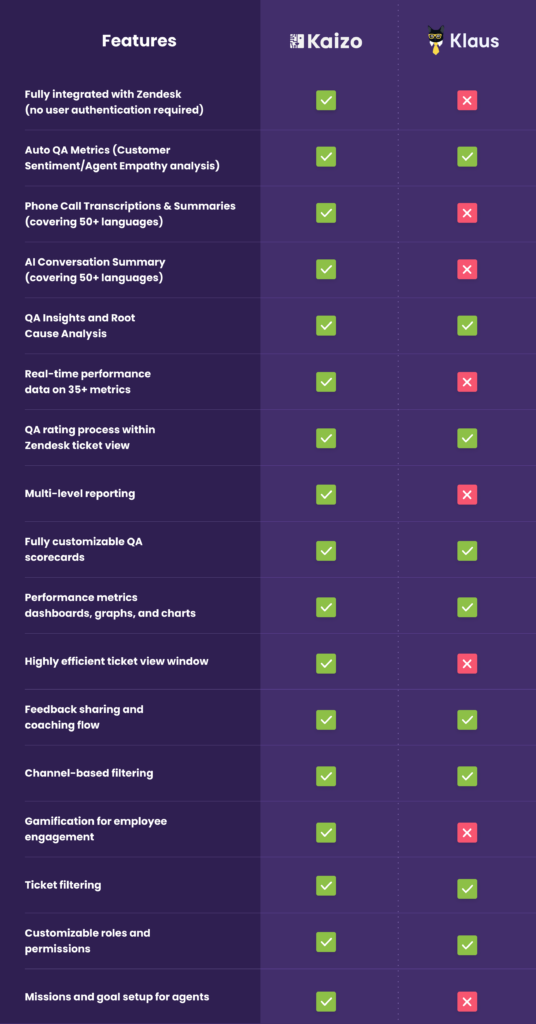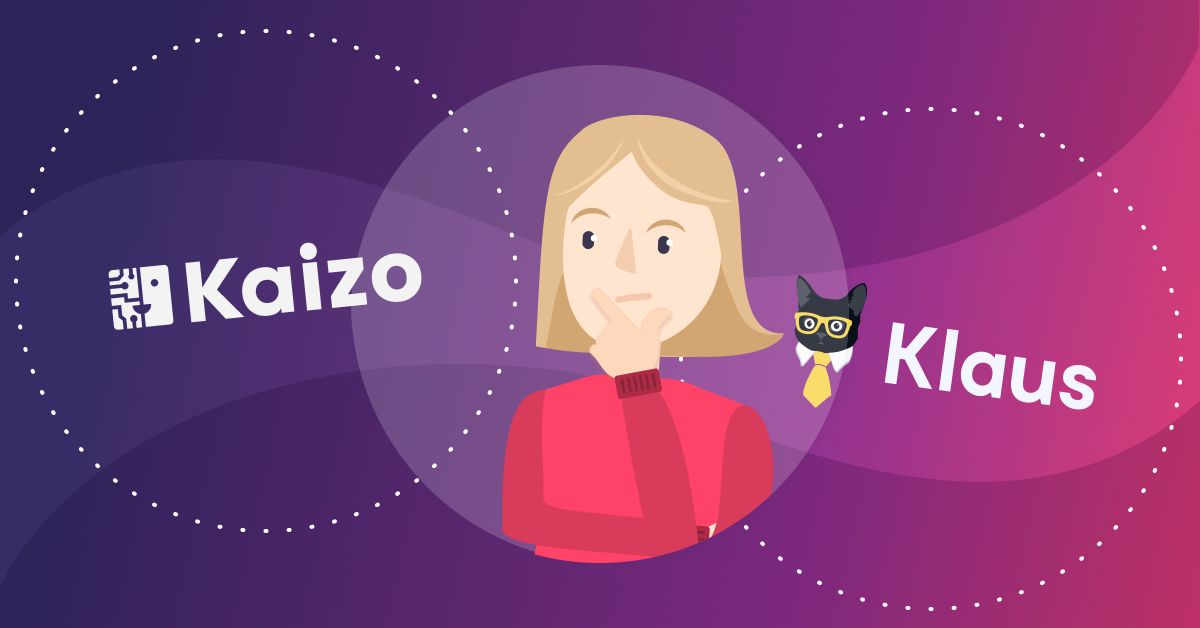Searching for the perfect tool to help with quality assurance operations? If so, Kaizo may be the perfect option for you as an alternative to Klaus. Both provide leading automated QA, ticket filtering, and coaching capabilities. However, Kaizo wins when it comes to employee engagement and advanced reporting as well as gamification and AI-based capabilities.
We’re taking a look at the similarities and differences between the two so that by the end of this post, you’ll be able to tell which solution checks all your must-haves and nice-to-haves. Here’s a side-by-side comparison of the two customer support quality management platforms.
Kaizo vs Klaus: Quick comparison

Kaizo vs Klaus: Which is best?
Let’s start from the basics: Both tools will help you with most core QA needs.
Both Kaizo and Klaus are strong when it comes to automated quality assurance as well as ticket filtering and scoring.
However, there are a couple of significant differences between the two that will get you to try Kaizo first if you’re going to be using a contact center quality assurance software for the long run.
Let’s compare Kaizo vs Klaus side-by-side to determine which is the best fit for you by exploring the similarities and differences between them.
Kaizo vs Klaus: Similarities
Kaizo and Klaus are two customer support tools meant to help with your operations and QA. They’re right for you if you’re looking to provide quick support, answer all inquiries correctly, enhance customer experience, and foster empathy in agents’ interactions.
Both tools are used by managers, agents, and QA raters as their core modules cater to diverse needs and use cases.
Their shared functionalities include:
- Automated quality assurance
- QA insights and root cause analysis
- QA rating within Zendesk
- Customizable QA scorecards
- Detailed performance metrics
- Agent feedback and coaching
- Ticket filtering
- Customizable roles and user permissions
- Channel-based filtering
At first glance, this might seem like enough to help you handle and prioritize tickets faster, train your team, and keep up with agent performance.
However, Klaus is missing a couple of the features that can help you leverage all your data, speed up support, and keep your agents engaged too.
Kaizo vs Klaus: Differences
Let’s dig into each of the differences in detail.
Workforce engagement and gamification
While Kaizo and Klaus both have equally powerful coaching tools, Klaus simply doesn’t offer any real option for workforce engagement. Kaizo is one of the few customer support QA tools out there to provide agent engagement.
Kaizo’s Missions features use a gamified approach to ensure outstanding customer service during times of increased demand and to reduce backlogs. The tool assigns each team member an avatar of a ninja, who is rewarded for meeting targets in speed, quality, and productivity. This lets you achieve agent success through personalized goals, transparent communication, and easy goal tracking.
AI capabilities
Kaizo uses artificial intelligence to help you improve your agent’s productivity as well as scale your customer support services. The AI-based call transcriptions and summaries cover over 50 languages so you can reach a global market. Kaizo’s AI Conversation Summary further condenses conversations into concise summaries so you can make informed decisions and speed up their evaluation process.
Klaus does provide some AI capabilities but they’re limited to AI-enhanced data enrichment, AI-powered performance reporting, and AI-driven conversation insights.
Data and reporting
While Klaus has brought in AI for its data analytics module, their insights and reporting functionalities simply fall short. For instance, while Klaus only provides tracking for 3-4 metrics, Kaizo equips you with real-time performance data on 35+ metrics.
Additionally, Klaus has no multi-level reporting, while Kaizo lets you build reports on an agent, team, and company level.
Zendesk integration
Both tools can be used by Zendesk users but Klaus falls short when it comes to user authentication and its ticket view window.
With Zendesk and Kaizo all the authorizations have already been done. You just need to install Kaizo and you can use it right away from within Zendesk. This is just a matter of a few clicks but most tools that work with data (including Klaus) don’t offer this complete integration.
The ticket window view within Kaizo (i.e. how the end-user in Kaizo sees the conversation from Zendesk) is also much better than what Klaus offers thanks to:
- A higher level of detail for data pulled from Zendesk
- Top performance metrics such as CSAT, FRT, and PR
- Status changes to understand if the agent followed the right ticket-handling processes
- Its AI elements such as autoanalysis of customer sentiment and agent empathy as well as an AI Summary for entire tickets
Pricing
Another core issue with Klaus is their lack of pricing transparency. You simply can’t know how much you have to pay (or how many users you get with each plan) unless you make an official cost request. At Kaizo we believe in keeping things fair and transparent so costs are available on our pricing page for everyone.
So, which one suits you best?
Agent disengagement is single handedly responsible for a plethora of issues like declining productivity, higher absenteeism, negative attitudes, and poor or fewer customer interactions. So your next quality assurance tool for customer support must come with a workforce engagement feature. Kaizo is one of the few such tools to help with this. Its Missions rely on gamification to empower your agents with purposeful objectives and foster a sense of purpose so they can succeed.
Kaizo will also help you fully leverage your performance insights. This is another core pillar in driving better results and giving your agents more transparency into their work and your own QA process. Hence, you can use Kaizo to make data-driven decisions as well as spot patterns, trends, and areas for improvement. Filtering performance results will further help you gain an in-depth understanding of the effectiveness of your individual support channels.
Try for free!
Our comparison can only give you an up-close look at what each tool has to offer. Next, you really need to take the tools for a test drive.
Want a closer look at Kaizo and its latest Samurai AI extension? Try them for free or book a demo to see them in action for your exact requirements.




